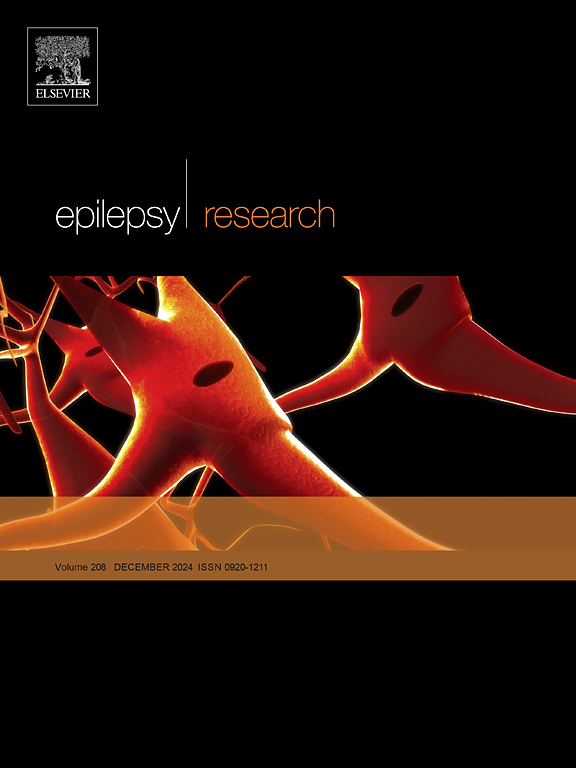Outcomes of surgically and non-surgically managed temporal encephalocoeles in the context of drug-resistant temporal lobe epilepsy: A retrospective single-centre case series
IF 2
4区 医学
Q3 CLINICAL NEUROLOGY
引用次数: 0
Abstract
Introduction
Temporal encephalocoeles are a recognised cause of drug-resistant temporal lobe epilepsy (TLE), with uncertain associations to epileptogenesis and an unclear optimal management approach. Operative management, particularly resective temporal lobe surgery, has been proposed, but outcomes and decision-making criteria remain debated. This study aims to evaluate the outcomes of surgically and non-surgically managed patients with temporal encephalocoeles in the context of drug-resistant TLE, focusing on seizure freedom rates, postoperative complications and factors influencing management decisions.
Methods
A retrospective, single-centre study was conducted based on all adult TLE patients with temporal encephalocoeles encountered between March 2017 and August 2023. Patients were classified into three groups: those discussed at an epilepsy surgery multidisciplinary team (MDT) meeting and managed surgically (surgical group), those discussed at an MDT and managed non-surgically (non-surgical group) and those radiologically identified by reporting neuroradiologists but not discussed at MDT (radiologically diagnosed group). Clinical, electrophysiological, radiological and surgical data were compared across the groups, including radiological features of raised intracranial pressure (ICP) that have been postulated as a cause for temporal encephaloceles.
Results
We included 24 adult patients with temporal encephalocoeles: eight in the surgical group, eight in the non-surgical group and eight in the radiologically diagnosed group. The mean age at diagnosis was 39.3 ± 13.6 years and clinical features were comparable across groups. Operative management was decided by an experienced epilepsy surgery MDT, involving resection of the anterior temporal pole with (4/8, 50 %) or without (50 %) mesial temporal structures, resulted in a seizure freedom rate of 87.5 %. In contrast, no patient in the non-surgical or radiologically diagnosed groups achieved seizure freedom (0 %). Postoperative complications included one patient who developed hydrocephalus and required a ventriculoperitoneal shunt, and another who developed a pseudomeningocoele. Radiological markers of raised ICP were broadly similar across the groups, with the exception of increased optic nerve sheath diameter in the non-surgical group (p = 0.032).
Conclusion
Our study demonstrates that excellent post-operative outcomes are achievable with temporal lobe resections. A standardised presurgical evaluation pathway and management protocol are essential to ensure timely identification of temporal encephalocoeles on imaging, facilitating preoperative planning and optimising surgical outcomes. CSF hydrodynamic disturbances may occur after surgery for encephaloceles and individualised evaluation is therefore crucial to select the most appropriate management approach.
在耐药颞叶癫痫的背景下,手术和非手术治疗颞叶脑室的结果:回顾性单中心病例系列
颞叶脑腔是公认的耐药颞叶癫痫(TLE)的病因,与癫痫发生的关系不确定,最佳治疗方法也不清楚。手术治疗,特别是切除颞叶手术,已经提出,但结果和决策标准仍有争议。本研究旨在评估在耐药TLE背景下手术和非手术治疗颞叶脑膨出患者的预后,重点关注癫痫发作自由率、术后并发症和影响治疗决策的因素。方法对2017年3月至2023年8月期间所有颞叶脑积水的成人TLE患者进行回顾性、单中心研究。患者被分为三组:在癫痫外科多学科小组(MDT)会议上讨论并进行手术治疗的患者(手术组),在MDT上讨论并进行非手术治疗的患者(非手术组),以及由神经放射学家报告放射学鉴定但未在MDT上讨论的患者(放射学诊断组)。比较两组患者的临床、电生理、放射学和外科数据,包括颅内压升高的放射学特征,颅内压升高被认为是颞叶性脑膨出的原因。结果本组共纳入24例颞叶脑膨出的成人患者,其中手术组8例,非手术组8例,影像学诊断组8例。诊断时平均年龄为39.3 ± 13.6岁,两组临床特征具有可比性。手术处理由经验丰富的癫痫外科MDT决定,包括切除颞前极,伴有(4/ 8,50 %)或不伴有(50 %)颞内缘结构,癫痫发作自由率为87.5 %。相比之下,在非手术或放射诊断组中,没有患者实现癫痫发作自由(0 %)。术后并发症包括一名患者出现脑积水并需要脑室-腹膜分流术,另一名患者出现假性脑膜膨出。除了非手术组视神经鞘直径增加(p = 0.032)外,各组间ICP升高的影像学指标大体相似。结论本研究表明,颞叶切除术可获得良好的术后效果。标准化的术前评估途径和处理方案是确保及时识别颞叶脑膨出的影像学,促进术前计划和优化手术结果的必要条件。脑膨出手术后可能出现脑脊液流体动力学紊乱,因此个体化评估对于选择最合适的治疗方法至关重要。
本文章由计算机程序翻译,如有差异,请以英文原文为准。
求助全文
约1分钟内获得全文
求助全文
来源期刊

Epilepsy Research
医学-临床神经学
CiteScore
0.10
自引率
4.50%
发文量
143
审稿时长
62 days
期刊介绍:
Epilepsy Research provides for publication of high quality articles in both basic and clinical epilepsy research, with a special emphasis on translational research that ultimately relates to epilepsy as a human condition. The journal is intended to provide a forum for reporting the best and most rigorous epilepsy research from all disciplines ranging from biophysics and molecular biology to epidemiological and psychosocial research. As such the journal will publish original papers relevant to epilepsy from any scientific discipline and also studies of a multidisciplinary nature. Clinical and experimental research papers adopting fresh conceptual approaches to the study of epilepsy and its treatment are encouraged. The overriding criteria for publication are novelty, significant clinical or experimental relevance, and interest to a multidisciplinary audience in the broad arena of epilepsy. Review articles focused on any topic of epilepsy research will also be considered, but only if they present an exceptionally clear synthesis of current knowledge and future directions of a research area, based on a critical assessment of the available data or on hypotheses that are likely to stimulate more critical thinking and further advances in an area of epilepsy research.
 求助内容:
求助内容: 应助结果提醒方式:
应助结果提醒方式:


